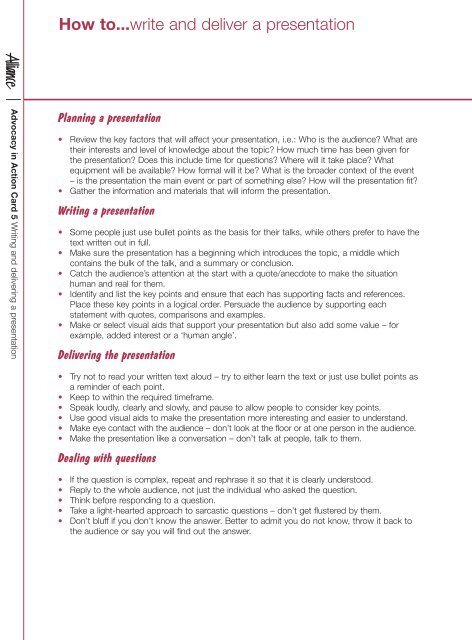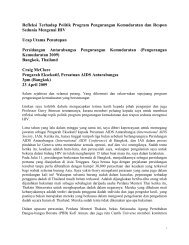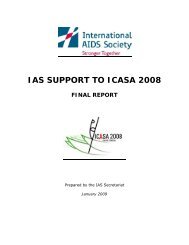Advocacy in Action - International AIDS Society
Advocacy in Action - International AIDS Society
Advocacy in Action - International AIDS Society
Create successful ePaper yourself
Turn your PDF publications into a flip-book with our unique Google optimized e-Paper software.
How to...write and deliver a presentation<br />
<strong>Advocacy</strong> <strong>in</strong> <strong>Action</strong> Card 5 Writ<strong>in</strong>g and deliver<strong>in</strong>g a presentation<br />
Plann<strong>in</strong>g a presentation<br />
• Review the key factors that will affect your presentation, i.e.: Who is the audience? What are<br />
their <strong>in</strong>terests and level of knowledge about the topic? How much time has been given for<br />
the presentation? Does this <strong>in</strong>clude time for questions? Where will it take place? What<br />
equipment will be available? How formal will it be? What is the broader context of the event<br />
– is the presentation the ma<strong>in</strong> event or part of someth<strong>in</strong>g else? How will the presentation fit?<br />
• Gather the <strong>in</strong>formation and materials that will <strong>in</strong>form the presentation.<br />
Writ<strong>in</strong>g a presentation<br />
• Some people just use bullet po<strong>in</strong>ts as the basis for their talks, while others prefer to have the<br />
text written out <strong>in</strong> full.<br />
• Make sure the presentation has a beg<strong>in</strong>n<strong>in</strong>g which <strong>in</strong>troduces the topic, a middle which<br />
conta<strong>in</strong>s the bulk of the talk, and a summary or conclusion.<br />
• Catch the audience’s attention at the start with a quote/anecdote to make the situation<br />
human and real for them.<br />
• Identify and list the key po<strong>in</strong>ts and ensure that each has support<strong>in</strong>g facts and references.<br />
Place these key po<strong>in</strong>ts <strong>in</strong> a logical order. Persuade the audience by support<strong>in</strong>g each<br />
statement with quotes, comparisons and examples.<br />
• Make or select visual aids that support your presentation but also add some value – for<br />
example, added <strong>in</strong>terest or a ‘human angle’.<br />
Deliver<strong>in</strong>g the presentation<br />
• Try not to read your written text aloud – try to either learn the text or just use bullet po<strong>in</strong>ts as<br />
a rem<strong>in</strong>der of each po<strong>in</strong>t.<br />
• Keep to with<strong>in</strong> the required timeframe.<br />
• Speak loudly, clearly and slowly, and pause to allow people to consider key po<strong>in</strong>ts.<br />
• Use good visual aids to make the presentation more <strong>in</strong>terest<strong>in</strong>g and easier to understand.<br />
• Make eye contact with the audience – don’t look at the floor or at one person <strong>in</strong> the audience.<br />
• Make the presentation like a conversation – don’t talk at people, talk to them.<br />
Deal<strong>in</strong>g with questions<br />
• If the question is complex, repeat and rephrase it so that it is clearly understood.<br />
• Reply to the whole audience, not just the <strong>in</strong>dividual who asked the question.<br />
• Th<strong>in</strong>k before respond<strong>in</strong>g to a question.<br />
• Take a light-hearted approach to sarcastic questions – don’t get flustered by them.<br />
• Don’t bluff if you don’t know the answer. Better to admit you do not know, throw it back to<br />
the audience or say you will f<strong>in</strong>d out the answer.
















